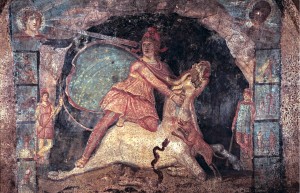The two Roman altar stones found last year under a cricket pavilion in Musselburgh, Scotland were so brittle that archaeologists were only able to turn them over this month. When they did so, they found that they were dedicated to Mithras, the bull-slaying deity of the eponymous mystery religion, and to Sol, the sun god of the late empire who features prominently in Mithraic iconography. These are the first Mithraic artifacts ever found in Scotland, and the farthest north.
The first stone has side panels depicting a lyre – a stringed musical instrument – and a griffon, a mythical beast which had a lion’s body and an eagle’s head and wings, along with pictures of a jug and bowl, objects which would have been used for pouring offerings on the altar.
The front face bears a carved inscription dedicating the altar to the god Mithras.
The front face of the second stone shows female heads which represent the four seasons – spring, summer, autumn and winter. All are wearing headdresses – spring flowers, summer foliage, autumn grapes and a shawl for winter.
The centre of the stone contains a carving of the face of a god, probably Sol, wearing a solar crown. The eyes, mouth and solar rays are all pierced and the hollowed rear shaft would probably have held a lantern or candle letting the light shine through.
An inscription on a panel beneath the four seasons is currently partially obscured but likely bears the name of the dedicator who is believed to be a Roman centurion, and the god to whom the altar is dedicated. Traces of red and white paint are still visible beneath the inscription panel suggesting that it was originally brightly painted at least in part.
The altars were toppled in antiquity and were thus found face down with several large cracks and breaks in the stone. AOC Archaeology Group, the team contracted to survey the site for archaeological remains before construction, boxed them up to keep them from breaking into pieces and put them in storage. Archaeologists could therefore only examine the back and sides of the altar stones. At that time they mistakenly thought one of them was dedicated to Jupiter. When they finally turned them over, the archaeologists were overjoyed to find the far more rare and archaeologically significant Mithraic iconography.
 Mithraism had a large following among the Roman legions between the 1st and 4th centuries AD. Reliefs and grottos dedicated to his worship (Mithraeums) followed the path of the army, from Italy to the Danube to Germany to Palestine to England to North Africa. Five Mithraeums have been found in Britain, three of them along Hadrian’s wall. By the reign of Aurelian (270 – 275 AD), Sol Invictus had become a major figure in the Roman pantheon, and he and Mithras would be theologically merged together, along with the Greek sun god Helios.
Mithraism had a large following among the Roman legions between the 1st and 4th centuries AD. Reliefs and grottos dedicated to his worship (Mithraeums) followed the path of the army, from Italy to the Danube to Germany to Palestine to England to North Africa. Five Mithraeums have been found in Britain, three of them along Hadrian’s wall. By the reign of Aurelian (270 – 275 AD), Sol Invictus had become a major figure in the Roman pantheon, and he and Mithras would be theologically merged together, along with the Greek sun god Helios.
These altars date to the late 2nd century, well into the Roman occupation of Scotland which began in 80 AD. Since, as a mystery religion, Mithraism didn’t leave behind piles of scriptures and letters and parables written and shared by its adherents, the bulk of what we know about it comes from carved stone like these altars. This discovery is of major importance, therefore, to our understanding of Roman military culture in Scotland as well as to our understanding of Mithraism as a whole.
Very cool! You don’t suppose they were left there by the 9th Legion, do you? :no: :no:
The revelation is suspiciously well-timed to coincide with the latest The Eagle of the Ninth movie adaptation. :shifty:
I am shocked to see Mithraism referenced outside of atheist arguments. Shocked, I tell you!
:ohnoes: <- artist's interpretation of what shocked might look like.
Thankfully Mithras is cool enough to transcend years of being mired in the swamps of Internet atheism. 😎
What a discovery!
:yes:
Fascinating stuff. Thanks for an interesting article.
My pleasure. :hattip: